Torsemide (injection)
Editor-In-Chief: C. Michael Gibson, M.S., M.D. [1]; Associate Editor(s)-in-Chief: Adeel Jamil, M.D. [2]
Disclaimer
WikiDoc MAKES NO GUARANTEE OF VALIDITY. WikiDoc is not a professional health care provider, nor is it a suitable replacement for a licensed healthcare provider. WikiDoc is intended to be an educational tool, not a tool for any form of healthcare delivery. The educational content on WikiDoc drug pages is based upon the FDA package insert, National Library of Medicine content and practice guidelines / consensus statements. WikiDoc does not promote the administration of any medication or device that is not consistent with its labeling. Please read our full disclaimer here.
Overview
Torsemide (injection) is a cardiovascular agent and loop diuretic that is FDA approved for the treatment of edema associated with congestive heart failure, renal disease, or hepatic disease. Common adverse reactions include polyuria and rhinitis.
Adult Indications and Dosage
FDA-Labeled Indications and Dosage (Adult)
- Torsemide Injection is indicated for the treatment of edema associated with congestive heart failure, renal disease, or hepatic disease. Use of torsemide has been found to be effective for the treatment of edema associated with chronic renal failure. Chronic use of any diuretic in hepatic disease has not been studied in adequate and well-controlled trials.
- Torsemide Injection is indicated when a rapid onset of diuresis is desired or when oral administration is impractical.
- Torsemide Injection is indicated for the treatment of hypertension alone or in combination with other antihypertensive agents.
Dosing information
General
- Special dosage adjustment in the elderly is not necessary.
- Because of the high bioavailability of torsemide, oral and intravenous doses are therapeutically equivalent, so patients may be switched to and from the intravenous form with no change in dose. Torsemide injection should be administered either slowly as a bolus over a period of 2 minutes or administered as a continuous infusion.
- If torsemide is administered through an IV line, it is recommended that, as with other IV injections, the IV line be flushed with Normal Saline (Sodium Chloride Injection) before and after administration. Torsemide injection is formulated above pH 8.3. Flushing the line is recommended to avoid the potential for incompatibilities caused by differences in pH which could be indicated by color change, haziness or the formation of a precipitate in the solution.
- If torsemide injection is administered as a continuous infusion, stability has been demonstrated through 24 hours at room temperature in plastic containers for the following fluids and concentrations:
- 200 mg torsemide (10 mg/mL) added to:
- 250 mL Dextrose 5% in Water
- 250 mL 0.9% Sodium Chloride
- 500 mL 0.45% Sodium Chloride
- 50 mg torsemide (10 mg/mL) added to:
- 500 mL Dextrose 5% in Water
- 500 mL 0.9% Sodium Chloride
- 500 mL 0.45% Sodium Chloride
- Before administration, the solution of torsemide injection should be visually inspected for discoloration and particulate matter. If either is found, the vial should not be used.
Congestive Heart Failure
- The usual initial dose is 10 mg or 20 mg of once daily intravenous torsemide. If the diuretic response is inadequate, the dose should be titrated upward by approximately doubling until the desired diuretic response is obtained. Single doses higher than 200 mg have not been adequately studied.
Chronic Renal Failure
- The usual initial dose of torsemide is 20 mg of once daily intravenous torsemide. If the diuretic response is inadequate, the dose should be titrated upward by approximately doubling until the desired diuretic response is obtained. Single doses higher than 200 mg have not been adequately studied.
Hepatic Cirrhosis
- The usual initial dose is 5 mg or 10 mg of once daily intravenous torsemide, administered together with an aldosterone antagonist or a potassium-sparing diuretic. If the diuretic response is inadequate, the dose should be titrated upward by approximately doubling until the desired diuretic response is obtained. Single doses higher than 40 mg have not been adequately studied.
- Chronic use of any diuretic in hepatic disease has not been studied in adequate and well-controlled trials.
Hypertension
- The usual initial dose is 5 mg once daily. If the 5 mg dose does not provide adequate reduction in blood pressure within 4 to 6 weeks, the dose may be increased to 10 mg daily. If the response to 10 mg is insufficient, an additional anti-hypertensive agent should be added to the treatment regimen.
Off-Label Use and Dosage (Adult)
Guideline-Supported Use
There is limited information regarding Off-Label Guideline-Supported Use of Torsemide (injection) in adult patients.
Non–Guideline-Supported Use
There is limited information regarding Off-Label Non–Guideline-Supported Use of Torsemide (injection) in adult patients.
Pediatric Indications and Dosage
FDA-Labeled Indications and Dosage (Pediatric)
There is limited information regarding Torsemide (injection) FDA-Labeled Indications and Dosage (Pediatric) in the drug label.
Off-Label Use and Dosage (Pediatric)
Guideline-Supported Use
There is limited information regarding Off-Label Guideline-Supported Use of Torsemide (injection) in pediatric patients.
Non–Guideline-Supported Use
There is limited information regarding Off-Label Non–Guideline-Supported Use of Torsemide (injection) in pediatric patients.
Contraindications
- Torsemide Injection is contraindicated in patients with known hypersensitivity to torsemide or to sulfonylureas.
- Torsemide Injection is contraindicated in patients who are anuric.
Warnings
Hepatic Disease with Cirrhosis and Ascites
- Torsemide should be used with caution in patients with hepatic disease with cirrhosis and ascites, since sudden alterations of fluid and electrolyte balance may precipitate hepatic coma. In these patients, diuresis with torsemide (or any other diuretic) is best initiated in the hospital. To prevent hypokalemia and metabolic alkalosis, an aldosterone antagonist or potassium-sparing drug should be used concomitantly with torsemide.
Ototoxicity
- Tinnitus and hearing loss (usually reversible) have been observed after rapid intravenous injection of other loop diuretics and have also been observed after oral Torsemide. It is not certain that these events were attributable to torsemide. Ototoxicity has also been seen in animal studies when very high plasma levels of torsemide were induced. Administered intravenously, torsemide should be injected slowly over 2 minutes, and single doses should not exceed 200 mg.
Volume and Electrolyte Depletion
- Patients receiving diuretics should be observed for clinical evidence of electrolyte imbalance, hypovolemia, or prerenal azotemia. Symptoms of these disturbances may include one or more of the following: dryness of the mouth, thirst, weakness, lethargy, drowsiness, restlessness, muscle pains or cramps, muscular fatigue, hypotension, oliguria, tachycardia, nausea, and vomiting. Excessive diuresis may cause dehydration, blood-volume reduction, and possibly thrombosis and embolism, especially in elderly patients. In patients who develop fluid and electrolyte imbalances, hypovolemia, or prerenal azotemia, the observed laboratory changes may include hyper- or hyponatremia, hyper- or hypochloremia, hyper- or hypokalemia, acid-base abnormalities, and increased blood urea nitrogen (BUN). If any of these occur, torsemide should be discontinued until the situation is corrected; torsemide may be restarted at a lower dose.
- In controlled studies in the United States, torsemide was administered to hypertensive patients at doses of 5 mg or 10 mg daily. After 6 weeks at these doses, the mean decrease in serum potassium was approximately 0.1 mEq/L. The percentage of patients who had a serum potassium level below 3.5 mEq/L at any time during the studies was essentially the same in patients who received torsemide (1.5%) as in those who received placebo (3%). In patients followed for 1 year, there was no further change in mean serum potassium levels. In patients with congestive heart failure, hepatic cirrhosis, or renal disease treated with torsemide at doses higher than those studied in United States antihypertensive trials, hypokalemia was observed with greater frequency, in a dose-related manner.
- In patients with cardiovascular disease, especially those receiving digitalis glycosides, diuretic-induced hypokalemia may be a risk factor for the development of arrhythmias. The risk of hypokalemia is greatest in patients with cirrhosis of the liver, in patients experiencing a brisk diuresis, in patients who are receiving inadequate oral intake of electrolytes, and in patients receiving concomitant therapy with corticosteroids or ACTH.
- Periodic monitoring of serum potassium and other electrolytes is advised in patients treated with torsemide.
PRECAUTIONS
Laboratory Tests
- Calcium
- Single doses of torsemide increased the urinary excretion of calcium by normal subjects, but serum calcium levels were slightly increased in 4 to 6 week hypertension trials. In a long-term study of patients with congestive heart failure, the average 1 year change in serum calcium was a decrease of 0.1 mg/dL (0.02 mmol/L). Among 426 patients treated with torsemide for an average of 11 months, hypocalcemia was not reported as an adverse event.
- Magnesium
- Single doses of torsemide caused healthy volunteers to increase their urinary excretion of magnesium, but serum magnesium levels were slightly increased in 4 to 6 week hypertension trials. In long-term hypertension studies, the average 1 year change in serum magnesium was an increase of 0.03 mg/dL (0.01 mmol/L). Among 426 patients treated with torsemide for an average of 11 months, one case of hypomagnesemia (1.3 mg/dL [0.53 mmol/L]) was reported as an adverse event.
- In a long-term clinical study of torsemide in patients with congestive heart failure, the estimated annual change in serum magnesium was an increase of 0.2 mg/dL (0.08 mmol/L), but these data are confounded by the fact that many of these patients received magnesium supplements. In a 4 week study in which magnesium supplementation was not given, the rate of occurrence of serum magnesium levels below 1.7 mg/dL (0.7 mmol/L) was 6% and 9% in the groups receiving 5 mg and 10 mg of torsemide, respectively.
- Blood Urea Nitrogen (BUN), Creatinine and Uric Acid
- Torsemide produces small dose-related increases in each of these laboratory values. In hypertensive patients who received 10 mg of torsemide daily for 6 weeks, the mean increase in blood urea nitrogen was 1.8 mg/dL (0.6 mmol/L), the mean increase in serum creatinine was 0.05 mg/dL (4 mmol/L), and the mean increase in serum uric acid was 1.2 mg/dL (70 mmol/L). Little further change occurred with long-term treatment, and all changes reversed when treatment was discontinued.
- Symptomatic gout has been reported in patients receiving torsemide, but its incidence has been similar to that seen in patients receiving placebo.
- Glucose
- Hypertensive patients who received 10 mg of daily torsemide experienced a mean increase in serum glucose concentration of 5.5 mg/dL (0.3 mmol/L) after 6 weeks of therapy, with a further increase of 1.8 mg/dL (0.1 mmol/L) during the subsequent year. In long-term studies in diabetics, mean fasting glucose values were not significantly changed from baseline. Cases of hyperglycemia have been reported but are uncommon.
- Serum Lipids
- In the controlled short-term hypertension studies in the United States, daily doses of 5 mg, 10 mg, and 20 mg of torsemide were associated with increases in total plasma cholesterol of 4, 4, and 8 mg/dL (0.1 to 0.2 mmol/L), respectively. The changes subsided during chronic therapy.
- In the same short-term hypertension studies, daily doses of 5 mg, 10 mg and 20 mg of torsemide were associated with mean increases in plasma triglycerides of 16, 13, and 71 mg/dL (0.15 to 0.8 mmol/L), respectively.
- In long-term studies of 5 mg to 20 mg of torsemide daily, no clinically significant differences from baseline lipid values were observed after 1 year of therapy.
- Other
- n long-term studies in hypertensive patients, torsemide has been associated with small mean decreases in hemoglobin, hematocrit, and erythrocyte count and small mean increases in white blood cell count, platelet count, and serum alkaline phosphatase. Although statistically significant, all of these changes were medically inconsequential. No significant trends have been observed in any liver enzyme tests other than alkaline phosphatase.
Adverse Reactions
Clinical Trials Experience
- At the time of approval, torsemide had been evaluated for safety in approximately 4000 subjects: over 800 of these subjects received torsemide for at least 6 months, and over 380 were treated for more than 1 year. Among these subjects were 564 who received torsemide during United States-based trials in which 274 other subjects received placebo.
- The reported side effects of torsemide were generally transient, and there was no relationship between side effects and age, sex, race, or duration of therapy. Discontinuation of therapy due to side effects occurred in 3.5% of United States patients treated with torsemide and in 4.4% of patients treated with placebo. In studies conducted in the United States and Europe, discontinuation rates due to side effects were 3% (38/1250) with torsemide and 3.4% (13/380) with furosemide in patients with congestive heart failure, 2% (8/409) with torsemide and 4.8% (11/230) with furosemide in patients with renal insufficiency, and 7.6% (13/170) with torsemide and 0% (0/33) with furosemide in patients with cirrhosis.
- The most common reasons for discontinuation of therapy with torsemide were (in descending order of frequency) dizziness, headache, nausea, weakness, vomiting, hyperglycemia, excessive urination, hyperuricemia, hypokalemia, excessive thirst, hypovolemia, impotence, esophageal hemorrhage, and dyspepsia. Dropout rates for these adverse events ranged from 0.1% to 0.5%.
- The side effects considered possibly or probably related to study drug that occurred in United States placebo-controlled trials in more than 1% of patients treated with torsemide are shown in Table 1.
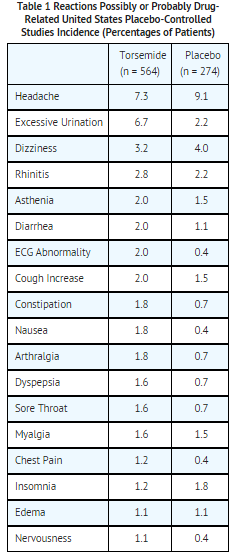
- The daily doses of torsemide used in these trials ranged from 1.25 mg to 20 mg, with most patients receiving 5 mg to 10 mg; the duration of treatment ranged from 1 to 52 days, with a median of 41 days. Of the side effects listed in the table, only “excessive urination” occurred significantly more frequently in patients treated with torsemide than in patients treated with placebo. In the placebo-controlled hypertension studies whose design allowed side-effect rates to be attributed to dose, excessive urination was reported by 1% of patients receiving placebo, 4% of those treated with 5 mg of daily torsemide, and 15% of those treated with 10 mg. The complaint of excessive urination was generally not reported as an adverse event among patients who received torsemide for cardiac, renal, or hepatic failure.
- Serious adverse events reported in the clinical studies for which a drug relationship could not be excluded were atrial fibrillation, chest pain, diarrhea, digitalis intoxication, gastrointestinal hemorrhage, hyperglycemia, hyperuricemia, hypokalemia, hypotension, hypovolemia, shunt thrombosis, rash, rectal bleeding, syncope, and ventricular tachycardia.
- Angioedema has been reported in a patient exposed to torsemide who was later found to be allergic to sulfa drugs.
- Of the adverse reactions during placebo-controlled trials listed without taking into account assessment of relatedness to drug therapy, arthritis and various other nonspecific musculoskeletal problems were more frequently reported in association with torsemide than with placebo, even though gout was somewhat more frequently associated with placebo. These reactions did not increase in frequency or severity with the dose of torsemide. One patient in the group treated with torsemide withdrew due to myalgia, and one in the placebo group withdrew due to gout.
- Hypokalemia
Postmarketing Experience
- The following adverse reactions have been identified during the post approval use of torsemide. Because these reactions are reported voluntarily from a population of uncertain size, it is not always possible to reliably estimate their frequency or establish a causal relationship to drug exposure. Adverse reactions reported include the following: leucopenia, thrombocytopenia.
- Serious skin reactions (i.e., Stevens-Johnson syndrome, toxic epidermal necrolysis) have been reported in association with torsemide use.
- Pancreatitis has been reported in association with torsemide use.
Drug Interactions
- In patients with essential hypertension, torsemide has been administered together with beta-blockers, ACE inhibitors, and calcium-channel blockers. In patients with congestive heart failure, torsemide has been administered together with digitalis glycosides, ACE inhibitors, and organic nitrates. None of these combined uses was associated with new or unexpected adverse events.
- Torsemide does not affect the protein binding of glyburide or of warfarin, the anticoagulant effect of phenprocoumon (a related coumarin derivative), or the pharmacokinetics of digoxin or carvedilol (a vasodilator/beta-blocker). In healthy subjects, coadministration of torsemide was associated with significant reduction in the renal clearance of spironolactone, with corresponding increases in the AUC. However, clinical experience indicates that dosage adjustment of either agent is not required.
- Because torsemide and salicylates compete for secretion by renal tubules, patients receiving high doses of salicylates may experience salicylate toxicity when torsemide is concomitantly administered. Also, although possible interactions between torsemide and nonsteroidal anti-inflammatory agents (including aspirin) have not been studied, coadministration of these agents with another loop diuretic (furosemide) has occasionally been associated with renal dysfunction.
- The natriuretic effect of torsemide (like that of many other diuretics) is partially inhibited by the concomitant administration of indomethacin. This effect has been demonstrated for torsemide under conditions of dietary sodium restriction (50 mEq/day) but not in the presence of normal sodium intake (150 mEq/day).
- The pharmacokinetic profile and diuretic activity of torsemide are not altered by cimetidine or spironolactone. Coadministration of digoxin is reported to increase the area under the curve for torsemide by 50%, but dose adjustment of torsemide is not necessary.
- Concomitant use of torsemide and cholestyramine has not been studied in humans but, in a study in animals, coadministration of cholestyramine decreased the absorption of orally administered torsemide. If torsemide and cholestyramine are used concomitantly, simultaneous administration is not recommended.
- Coadministration of probenecid reduces secretion of torsemide into the proximal tubule and thereby decreases the diuretic activity of torsemide.
- Other diuretics are known to reduce the renal clearance of lithium, inducing a high risk of lithium toxicity, so coadministration of lithium and diuretics should be undertaken with great caution, if at all. Coadministration of lithium and torsemide has not been studied.
- Other diuretics have been reported to increase the ototoxic potential of aminoglycoside antibiotics and of ethacrynic acid, especially in the presence of impaired renal function. These potential interactions with torsemide have not been studied.
Use in Specific Populations
Pregnancy
- There was no fetotoxicity or teratogenicity in rats treated with up to 5 mg/kg/day of torsemide (on a mg/kg basis, this is 15 times a human dose of 20 mg/day; on a mg/m2 basis, the animal dose is 10 times the human dose), or in rabbits, treated with 1.6 mg/kg/day (on a mg/kg basis, 5 times the human dose of 20 mg/kg/day; on a mg/m2 basis, 1.7 times this dose). Fetal and maternal toxicity (decrease in average body weight, increase in fetal resorption and delayed fetal ossification) occurred in rabbits and rats given doses 4 (rabbits) and 5 (rats) times larger. Adequate and well-controlled studies have not been carried out in pregnant women. Because animal reproduction studies are not always predictive of human response, this drug should be used during pregnancy only if clearly needed.
Pregnancy Category (AUS):
There is no Australian Drug Evaluation Committee (ADEC) guidance on usage of Torsemide (injection) in women who are pregnant.
Labor and Delivery
There is no FDA guidance on use of Torsemide (injection) during labor and delivery.
Nursing Mothers
- It is not known whether torsemide is excreted in human milk. Because many drugs are excreted in human milk, caution should be exercised when torsemide is administered to a nursing woman.
Pediatric Use
- Safety and effectiveness in pediatric patients have not been established.
- Administration of another loop diuretic to severely premature infants with edema due to patent ductus arteriosus and hyaline membrane disease has occasionally been associated with renal calcifications, sometimes barely visible on X-ray but sometimes in staghorn form, filling the renal pelves. Some of these calculi have been dissolved, and hypercalciuria has been reported to have decreased, when chlorothiazide has been coadministered along with the loop diuretic. In other premature neonates with hyaline membrane disease, another loop diuretic has been reported to increase the risk of persistent patent ductus arteriosus, possibly through a prostaglandin-E-mediated process. The use of torsemide in such patients has not been studied.
Geriatic Use
- Of the total number of patients who received torsemide in United States clinical studies, 24% were 65 or older while about 4% were 75 or older. No specific age-related differences in effectiveness or safety were observed between younger patients and elderly patients.
Gender
There is no FDA guidance on the use of Torsemide (injection) with respect to specific gender populations.
Race
There is no FDA guidance on the use of Torsemide (injection) with respect to specific racial populations.
Renal Impairment
There is no FDA guidance on the use of Torsemide (injection) in patients with renal impairment.
Hepatic Impairment
There is no FDA guidance on the use of Torsemide (injection) in patients with hepatic impairment.
Females of Reproductive Potential and Males
There is no FDA guidance on the use of Torsemide (injection) in women of reproductive potentials and males.
Immunocompromised Patients
There is no FDA guidance one the use of Torsemide (injection) in patients who are immunocompromised.
Administration and Monitoring
Administration
- Intravenous
Monitoring
There is limited information regarding Torsemide (injection) Monitoring in the drug label.
IV Compatibility
There is limited information regarding the compatibility of Torsemide (injection) and IV administrations.
Overdosage
- There is no human experience with overdoses of torsemide, but the signs and symptoms of overdosage can be anticipated to be those of excessive pharmacologic effect: dehydration, hypovolemia, hypotension, hyponatremia, hypokalemia, hypochloremic alkalosis, and hemoconcentration. Treatment of overdosage should consist of fluid and electrolyte replacement.
- Laboratory determinations of serum levels of torsemide and its metabolites are not widely available.
- No data are available to suggest physiological maneuvers (e.g., maneuvers to change the pH of the urine) that might accelerate elimination of torsemide and its metabolites. Torsemide is not dialyzable, so hemodialysis will not accelerate elimination.
Pharmacology

| |
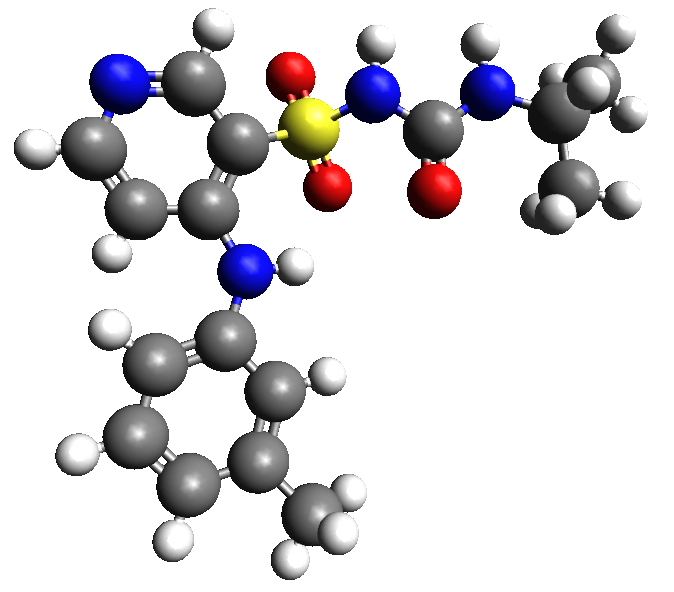
| |
Torsemide (injection)
| |
| Systematic (IUPAC) name | |
| N-[(isopropylamino)carbonyl]-4-[(3-methylphenyl)amino]pyridine-3-sulfonamide | |
| Identifiers | |
| CAS number | |
| ATC code | C03 |
| PubChem | |
| DrugBank | |
| Chemical data | |
| Formula | Template:OrganicBox atomTemplate:OrganicBox atomTemplate:OrganicBoxTemplate:OrganicBoxTemplate:OrganicBoxTemplate:OrganicBoxTemplate:OrganicBoxTemplate:OrganicBoxTemplate:OrganicBoxTemplate:OrganicBoxTemplate:OrganicBoxTemplate:OrganicBoxTemplate:OrganicBoxTemplate:OrganicBox atomTemplate:OrganicBoxTemplate:OrganicBox atomTemplate:OrganicBoxTemplate:OrganicBoxTemplate:OrganicBox atomTemplate:OrganicBoxTemplate:OrganicBoxTemplate:OrganicBoxTemplate:OrganicBox |
| Mol. mass | 348.421 g/mol |
| SMILES | & |
| Pharmacokinetic data | |
| Bioavailability | 80-90% |
| Protein binding | Highly bound (>99%). |
| Metabolism | Hepatic (80%) |
| Half life | 3.5 hours; Cirrhosis: 7-8 hours |
| Excretion | ? |
| Therapeutic considerations | |
| Pregnancy cat. |
C(US) |
| Legal status |
[[Prescription drug|Template:Unicode-only]](US) |
| Routes | Oral, IV |
Mechanism of Action
- Micropuncture studies in animals have shown that torsemide acts from within the lumen of the thick ascending portion of the loop of Henle, where it inhibits the Na+/K+/2Cl--carrier system. Clinical pharmacology studies have confirmed this site of action in humans, and effects in other segments of the nephron have not been demonstrated. Diuretic activity thus correlates better with the rate of drug excretion in the urine than with the concentration in the blood.
- Torsemide increases the urinary excretion of sodium, chloride, and water, but it does not significantly alter glomerular filtration rate, renal plasma flow, or acid-base balance.
Structure
Torsemide Injection is a diuretic of the pyridine-sulfonylurea class. Its chemical name is 1-isopropyl-3-[(4-m-toluidino-3-pyridyl)sulfonyl] urea and its structural formula is:
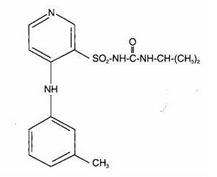
Pharmacodynamics
There is limited information regarding Torsemide (injection) Pharmacodynamics in the drug label.
Pharmacokinetics
- The volume of distribution of torsemide is 12 liters to 15 liters in normal adults or in patients with mild to moderate renal failure or congestive heart failure. In patients with hepatic cirrhosis, the volume of distribution is approximately doubled.
- In normal subjects the elimination half-life of torsemide is approximately 3.5 hours. Torsemide is cleared from the circulation by both hepatic metabolism (approximately 80% of total clearance) and excretion into the urine (approximately 20% of total clearance in patients with normal renal function). The major metabolite in humans is the carboxylic acid derivative, which is biologically inactive. Two of the lesser metabolites possess some diuretic activity, but for practical purposes metabolism terminates the action of the drug.
- Because torsemide is extensively bound to plasma protein (>99%), very little enters tubular urine via glomerular filtration. Most renal clearance of torsemide occurs via active secretion of the drug by the proximal tubules into tubular urine.
- In patients with decompensated congestive heart failure, hepatic and renal clearance are both reduced, probably because of hepatic congestion and decreased renal plasma flow, respectively. The total clearance of torsemide is approximately 50% of that seen in healthy volunteers, and the plasma half-life and AUC are correspondingly increased. Because of reduced renal clearance, a smaller fraction of any given dose is delivered to the intraluminal site of action, so at any given dose there is less natriuresis in patients with congestive heart failure than in normal subjects.
- In patients with renal failure, renal clearance of torsemide is markedly decreased but total plasma clearance is not significantly altered. A smaller fraction of the administered dose is delivered to the intraluminal site of action, and the natriuretic action of any given dose of diuretic is reduced. A diuretic response in renal failure may still be achieved if patients are given higher doses. The total plasma clearance and elimination half-life of torsemide remain normal under the conditions of impaired renal function because metabolic elimination by the liver remains intact.
- In patients with hepatic cirrhosis, the volume of distribution, plasma half-life, and renal clearance are all increased, but total clearance is unchanged.
- The pharmacokinetic profile of torsemide in healthy elderly subjects is similar to that in young subjects except for a decrease in renal clearance related to the decline in renal function that commonly occurs with aging. However, total plasma clearance and elimination half-life remain unchanged.
Nonclinical Toxicology
There is limited information regarding Torsemide (injection) Nonclinical Toxicology in the drug label.
Clinical Studies
Clinical Effects
- The diuretic effects of torsemide begin within 10 minutes of intravenous dosing and peak within the first hour. Diuresis lasts about 6 to 8 hours. In healthy subjects given single doses, the dose-response relationship for sodium excretion is linear over the dose range of 2.5 mg to 20 mg. The increase in potassium excretion is negligible after a single dose of up to 10 mg and only slight (5 mEq to 15 mEq) after a single dose of 20 mg.
Congestive Heart Failure
- Torsemide has been studied in controlled trials in patients with New York Heart Association Class II to Class IV congestive heart failure. Patients who received 10 mg to 20 mg of daily torsemide in these studies achieved significantly greater reductions in weight and edema than did patients who received placebo.
Nonanuric Renal Failure
- In single-dose studies in patients with nonanuric renal failure, high doses of torsemide (20 mg to 200 mg) caused marked increases in water and sodium excretion. In patients with nonanuric renal failure, severe enough to require hemodialysis, chronic treatment with up to 200 mg of daily torsemide has not been shown to change steady-state fluid retention. When patients in a study of acute renal failure received total daily doses of 520 mg to 1200 mg of torsemide, 19% experienced seizures. Ninety-six patients were treated in this study; 6/32 treated with torsemide experienced seizures, 6/32 treated with comparably high doses of furosemide experienced seizures, and 1/32 treated with placebo experienced a seizure.
Hepatic Cirrhosis
- When given with aldosterone antagonists, torsemide also caused increases in sodium and fluid excretion in patients with edema or ascites due to hepatic cirrhosis. Urinary sodium excretion rate relative to the urinary excretion rate of torsemide is less in cirrhotic patients than in healthy subjects (possibly because of the hyperaldosteronism and resultant sodium retention that are characteristic of portal hypertension and ascites). However, because of the increased renal clearance of torsemide in patients with hepatic cirrhosis, these factors tend to balance each other, and the result is an overall natriuretic response that is similar to that seen in healthy subjects. Chronic use of any diuretic in hepatic disease has not been studied in adequate and well-controlled trials.
Essential Hypertension
- In patients with essential hypertension, torsemide has been shown in controlled studies to lower blood pressure when administered once a day at doses of 5 mg to 10 mg. The antihypertensive effect is near maximal after 4 to 6 weeks of treatment, but it may continue to increase for up to 12 weeks. Systolic and diastolic supine and standing blood pressures are all reduced. There is no significant orthostatic effect, and there is only a minimal peak-trough difference in blood pressure reduction.
- The antihypertensive effects of torsemide are, like those of other diuretics, on the average greater in black patients (a low-renin population) than in nonblack patients.
- When torsemide is first administered, daily urinary sodium excretion increases for at least a week. With chronic administration, however, daily sodium loss comes into balance with dietary sodium intake. If the administration of torsemide is suddenly stopped, blood pressure returns to pretreatment levels over several days, without overshoot.
- Torsemide has been administered together with β-adrenergic blocking agents, ACE inhibitors, and calcium-channel blockers. Adverse drug interactions have not been observed, and special dosage adjustment has not been necessary.
How Supplied
Torsemide Injection, 10 mg/mL, is available as follows:
2 mL single dose vials in cartons of 10 – NDC# is 0517-0770-10 5 mL single dose vials in cartons of 10 – NDC# is 0517-0771-10
AMERICAN REGENT, INC. SHIRLEY, NY 11967
RQ1029-01 Revised February 2014
Storage
- Store at 20° to 25° C (68° to 77° F) (See USP controlled room temperature). DO NOT FREEZE.
Images
Drug Images
{{#ask: Page Name::Torsemide (injection) |?Pill Name |?Drug Name |?Pill Ingred |?Pill Imprint |?Pill Dosage |?Pill Color |?Pill Shape |?Pill Size (mm) |?Pill Scoring |?NDC |?Drug Author |format=template |template=DrugPageImages |mainlabel=- |sort=Pill Name }}
Package and Label Display Panel
PRINCIPAL DISPLAY PANEL - 2 mL Label
NDC 0517-0770-01
TORSEMIDE INJECTION
20 mg/2 mL (10 mg/mL)
2 mL SINGLE DOSE VIAL
FOR IV INJECTION
Rx Only
AMERICAN REGENT, INC. SHIRLEY, NY 11967

PRINCIPAL DISPLAY PANEL - 5 mL Label
NDC 0517-0771-01
TORSEMIDE INJECTION
50 mg/5 mL (10 mg/mL)
5 mL SINGLE DOSE VIAL
FOR IV INJECTION
Rx Only
AMERICAN REGENT, INC. SHIRLEY, NY 11967

PRINCIPAL DISPLAY PANEL - 2 mL Carton
NDC 0517-0770-10
TORSEMIDE INJECTION
20 mg/2 mL (10 mg/mL)
10 x 2 mL SINGLE DOSE VIALS
FOR INTRAVENOUS INJECTION
Sterile, non-pyrogenic solution
Rx Only
AMERICAN REGENT, INC. SHIRLEY, NY 11967
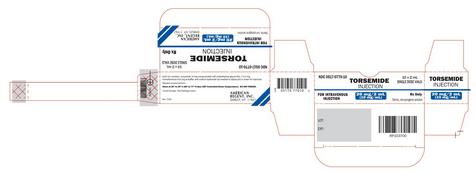
PRINCIPAL DISPLAY PANEL - 5 mL Carton
NDC 0517-0771-10
TORSEMIDE INJECTION
50 mg/5 mL (10 mg/mL)
10 x 5 mL SINGLE DOSE VIALS
FOR INTRAVENOUS INJECTION
Sterile, non-pyrogenic solution
Rx Only
AMERICAN REGENT, INC. SHIRLEY, NY 11967
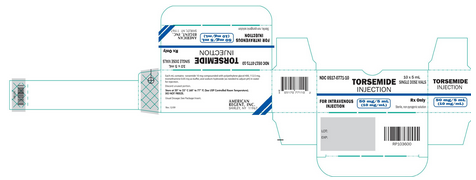
{{#ask: Label Page::Torsemide (injection) |?Label Name |format=template |template=DrugLabelImages |mainlabel=- |sort=Label Page }}
Patient Counseling Information
There is limited information regarding Torsemide (injection) Patient Counseling Information in the drug label.
Precautions with Alcohol
Alcohol-Torsemide (injection) interaction has not been established. Talk to your doctor about the effects of taking alcohol with this medication.
Brand Names
- TORSEMIDE [1]
Look-Alike Drug Names
There is limited information regarding Torsemide (injection) Look-Alike Drug Names in the drug label.
Drug Shortage Status
Price
References
The contents of this FDA label are provided by the National Library of Medicine.